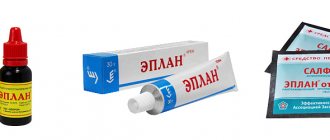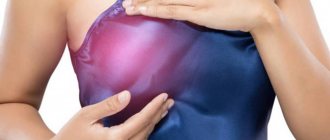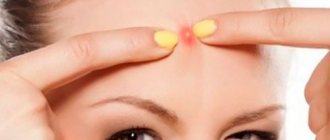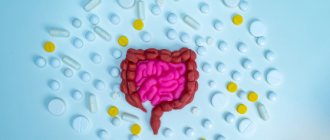December 5, 2020
Most infections are caused by streptococci and staphylococci. They live in the environment, inhabiting the skin, mucous membranes of the mouth, nose, and genitals. In 9–12% of cases, inflammation is provoked by corynebacteria, leprosy bacilli, tuberculosis, and campylobacter.
Healthy skin keeps germs out. This is prevented by the structure of the epidermis, the pH of sweat and sebum, and the antiseptic properties of the secretion of the sebaceous glands. When protection is violated, pustular rashes occur.
What is skin inflammation and what causes it?
The inflammatory process is a natural reaction of the body in response to irritants. Their roles may include:
- mechanical factors (violation of skin integrity as a result of injury);
- thermal (burn or frostbite);
- chemical (burn with acid or alkali);
- biologically determined (pathogenic bacteria, viruses, fungi, protozoa, allergic reaction).
The process can be acute or chronic, affecting the superficial and deep layers of the skin. Depending on the degree of damage, the intensity of symptoms and the recovery time of the skin vary.
This pathological process is usually represented by the following symptoms:
- Swelling. Due to the accumulation of fluid in the intercellular space, the skin becomes tense, stretched, and shiny.
- Hyperemia (redness). Small blood vessels dilate, and the permeability of their walls increases. Due to this, the skin acquires a pink-red, scarlet or crimson tint.
- Rashes. The type of rash depends on the cause that led to the inflammatory process.
- Exudation and oozing. Exudate is a liquid that is released under the influence of increased permeability of the walls of blood vessels and increased pressure in them. Depending on the composition, the exudate can be serous, purulent, putrefactive or hemorrhagic. Weeping occurs under the influence of serous exudate seeping through microcracks in the epidermis. Usually weeping appears at the site of burst bullae and blisters. As they dry, they become covered with wet yellowish-brown crusts, underneath which there are erosions.
- Suppuration. Pus is one of the types of exudate. The cause of its occurrence is usually pyogenic bacteria (for example, streptococci and staphylococci) and other microorganisms that penetrate wounds and microtraumas of the skin. Externally, pus looks like a cloudy and viscous liquid of white, yellowish, greenish or grayish color.
- Pain. The appearance of painful sensations is caused by compression of the nerve endings.
Mode of application
Methods of using antibacterial liniments depend on the specific drug and the inflammatory process. The process is described in the instructions.
Basically, ointments are applied as follows:
- For burn and wound injuries, ointments are applied in a layer 1-2 mm thick. The procedure is repeated 1-3 times during the day. The course of treatment is 7 days;
- for inflammation of the mucous membranes of the eye, liniment is placed under both eyelids no more than 3 times a day. The course ranges from 3 days to a week. In case of complications, it can be extended to 2 weeks;
- for skin inflammations, liniments are used up to three times a day for no longer than one week;
- for dermatological diseases, the drugs are used 2 times a day, for up to 7 days. Ointments are applied in a thin layer or pointwise.
What tasks should an anti-inflammatory cream for face and body cope with?
To combat these unpleasant symptoms, medications for external use are usually prescribed. These can be steroidal or non-steroidal anti-inflammatory drugs - gel, ointment or cream with anti-inflammatory and antibacterial effects. These products differ from each other in consistency, density, degree of absorption and the ratio of the main active ingredient and additional components.
- The gel is a dense and elastic product that holds its shape well due to the polymer base and has high osmotic properties. The gel usually contains no oils and fats, but contains up to 80% water. The use of gel is especially important in cases where it is necessary to ensure rapid absorption of active components without clogging pores and forming a greasy or sticky film on the skin. However, this product may cause additional dryness to the skin.
- Cream - compared to gel, it is a less dense product for external use. The cream contains oils and water. It absorbs well without leaving any traces on the skin. It lingers only on the surface layers of the skin.
- Ointment is a thick and viscous product made on the basis of vegetable or animal fat, less often mineral oil. The ointment ensures maximum penetration of the active components deep into the skin. This is especially important when the deeper layers of the skin are affected. However, it must be taken into account that ointments form a film on the skin that prevents the penetration of air, so such products are usually not applied to wet areas.
Depending on the nature and symptoms of skin lesions, anti-inflammatory creams for the face and body can solve one or more problems:
- Eliminate pathogenic microflora. Antibacterial creams are used for this purpose.
- Relieve pain syndrome. Creams suitable for solving this problem include synthetic anesthetics or essential oils of plants.
- Dry wet areas of the skin. Zinc and sulfur creams, as well as products based on essential oils (for example, tea tree and lavender), cope with this task.
- Soften and nourish the skin to accelerate regeneration. Various plant extracts, panthenol, propolis - all these components provide nourishment and softening to the skin.
How to choose antiviral ointments for children
Many people understand that the most “winning” tactic in confronting colds is preventing the disease. Therefore, many parents are wondering: what antiviral nasal ointment for children will work to help local immunity? However, not all products are suitable for your baby. The fact is that most drugs have restrictions based on the patient’s age; you should carefully read the instructions and not use inappropriate drugs that can upset the delicate balance of the baby’s immune system or damage organs that are not yet strong. Currently, the number of specific antiviral agents approved for use in pediatrics is limited.
The main active components of anti-inflammatory creams
Based on the nature of the active components, external agents are divided into hormonal and non-hormonal:
- Hormonal creams and ointments. Hormonal agents for external use are prescribed exclusively in severe cases. They allow you to achieve a relatively quick effect, due to which they are used mainly during periods of acute inflammation. Treatment with such creams and ointments should be carried out under the supervision of a physician, without exceeding the prescribed doses and duration of use of the cream. This is due to the possibility of developing serious side effects - up to skin atrophy, a decrease in the body's defenses and negative effects on internal organs.
- Non-hormonal. Such creams are mainly prescribed for mild inflammation or after the acute stage of the disease has passed. Unlike hormonal drugs, non-hormonal drugs can be used for a long time, as they are not addictive and have fewer side effects and contraindications.
Below is a list of the most common non-hormonal active ingredients found in anti-inflammatory creams:
- Zinc. This substance has antiseptic, astringent and drying properties, due to which it accelerates the process of drying wetness and removing exudate. Zinc-based creams and masks are actively used to combat acne and pimples.
- Sulfur. Sulfur creams have anti-inflammatory, antimicrobial and antiparasitic effects, dry out pustules and weeping, and produce a mild analgesic effect. However, sulfur has a fairly strong odor, which makes sulfur creams uncomfortable to use during the day.
- Retinol and retinoids. Vitamin A and its derivatives are widely used in the treatment of acne and pustules, psoriasis and other skin lesions. These substances promote skin cell renewal, stimulate collagen synthesis, and normalize the functioning of the sebaceous glands. At the same time, creams with vitamin A and its derivatives should be used only as prescribed by a doctor, since their irrational use can lead to new skin problems.
- Ichthyol. Ichthyol-based creams have anti-inflammatory, antiseptic and disinfectant properties. They are often prescribed to speed up the removal of exudate.
- Propolis. Creams with propolis have bactericidal, antifungal and analgesic properties, and help strengthen the walls of small blood vessels.
- Plant extracts. In the production of anti-inflammatory creams for the face and body, plant extracts and essential oils are widely used. For example, it can be aloe, calendula, nettle, mint, chamomile, ginger, turmeric, tea tree, arnica, kalanchoe, etc. La Cree Cream for sensitive skin can be used as an effective remedy. It contains extracts of string, violet and walnut, avocado oil, panthenol and bisabolol. These components help accelerate the recovery of affected skin areas, reduce inflammation and redness, accelerate regeneration, nourish and moisturize the skin.
- Deproteinized hemoderivative of dairy calves. Despite the fact that creams with this substance are banned in the USA and European countries, in Russia such products are used quite widely. Manufacturers emphasize that deproteinized hemoderivative from dairy calves helps accelerate the regeneration of affected skin areas.
- Methyluracil. Ointments and creams based on methyluracil have a pronounced anti-inflammatory effect, improve tissue trophism, stimulate cellular immune factors and promote skin regeneration.
Treatment of bacterial skin infections
It should start from the early stages and be carried out under the supervision of a specialist. In some cases, local treatment with antibacterial ointments and wiping with antiseptics is sufficient. Widespread rashes, deep pyoderma, require the prescription of systemic antibiotics. In chronic cases, the doctor may recommend autohemotherapy and immune drugs.
Surgical treatment is carried out if the abscess does not open on its own or if a rough scar must be avoided. Laser coagulation and physiotherapy are used to restore tissue.
It is important to identify and treat concomitant diseases, eliminate adverse external effects on the skin, and select nutrition.
Clinical researches
Clinical trials conducted by the company prove the high effectiveness, safety and tolerability of products for daily skin care for children with mild to moderate forms of atopic dermatitis. As a result of the therapy, it was noted that after using the cream, itching and irritation of the skin are significantly reduced, redness is removed, and the skin is moisturized.
Sources:
- Fokina R.A., Atopic dermatitis: stages of development of classification forms, Siberian Medical Journal, 2007
- A.N. Pampura, A.A. Chuslyaeva, Modern approaches to the treatment of atopic dermatitis in children
- N.N. Murashkin, A.I. Materikin, R.V. Epishev, E.T. Ambarchyan, Features of the course and prevention of diaper dermatitis in newborns and infants, journal Questions of Modern Pediatrics, 2015
Colds in childhood
Children easily exchange infections by contacting each other. Only the first months of life are relatively safe, when the child retains the passive immunity received from the mother. The baby is somewhat isolated: contact is often limited to family members. Unfortunately, the possibility of infection cannot be completely excluded even in infancy. Among preschoolers under five years of age, the highest incidence is observed, which is obviously associated with increased social contacts and visits to children's groups. “Sadovsky” children can get ARVI up to 10-15 times during the first year, then the frequency decreases by about half, but in subsequent years it remains quite high - 3-5 times a year. Repeated colds can deplete a child’s body, reduce defenses, delay normal development, contribute to the formation of “smoldering” foci of infection and allergies, and interfere with preventive vaccinations. Specific methods of prevention include vaccination. However, the vaccine works against a specific pathogen, for example, the influenza virus, but does not work against other infections, of which there are several hundred, as we know. Non-specific methods include hardening and the use of antiviral drugs according to the scheme proposed by your pediatrician.
Nasal antiviral ointments as a way to protect children from colds
Most often, a “cold” refers to a mild illness of the upper respiratory tract, which is caused by a viral infection. The entry point for ARVI pathogens is the mucous membrane of the upper respiratory tract, where inflammation is localized in most ARVIs. A severe course of acute respiratory viral infection with damage to the lower respiratory tract with the development of bronchitis and pneumonia may be associated with reduced levels of the child’s immunity. It is known that up to the age of 7 years, a child’s immunity undergoes changes about 4-5 times. For ARVI in the acute period, etiotropic therapy is usually used using antiviral drugs of both local and general action. The role of antiviral drugs is that they prevent the reproduction of viruses and help reduce the viral load on the body. In addition, antiviral therapy facilitates the course of the disease, reduces the likelihood of complications and reduces the risk of infection to those around the patient. For the treatment of ARVI and influenza, VIFERON Ointment can be used in children over 1 year of age. Pediatricians recommend VIFERON Gel for the youngest children, which is approved from 0 years.
Anti-inflammatory and symptomatic drugs are also used in the treatment of ARVI to relieve symptoms. Patients are prescribed bed rest, drinking rest, diet, and vitamin supplements. But antibiotics are used strictly according to indications and doctor’s prescription.
Mechanism of action of immunity in the nose
Most infectious agents enter the body from the surface of the mucous membranes, which are the initial portal of entry for most respiratory viruses. The immune system uses various mechanisms to fight infections. – In addition to increasing the activity of general systemic immunity, local immunity plays an important role in protecting against pathogenic viruses. It is this that helps to cope with those pathogens that have settled on the surface of the mucous membranes of the nasopharynx and prevents the further spread of infection inside.
Secretory A-type immunoglobulins are special protein substances - they play a major role in the prevention of disease or recovery. Specific prevention of viral infections involves the immune system of the mucous membranes. The IgA present on them, the action of which is aimed at neutralizing the infection, can come from blood serum or be secreted by cells of submucosal tissue.
An effective measure to protect the upper respiratory tract is the induction of immunoglobulins precisely at the sites of virus replication - the nasopharynx. Stimulating the production of high titer whey proteins is more effective for the lower respiratory tract.
Strengthening the activity of local immunity plays an important role in preventing infection of the body by certain viruses, especially influenza. Knowledge of the mechanism of formation of local immunity makes the search for means that provide protection of mucous membranes from infectious agents a solvable task. Thus, at the beginning of the last century, the theory of local immunity was formulated, and subsequently data was accumulated indicating the important role of local protective factors in a number of viral infections. With the discovery of immunoglobulin A and evidence of its secretion by mucosal cells, a new era in the development of applied immunology began.
In particular, it was found that IgA is the most important immunoglobulin, the main biological function of which is to protect the mucous membranes from infectious agents. The most likely mechanism of IgA neutralization of the virus is to prevent the virus from binding to target mucosal cells, although others are possible.
It was found that IgA can not only prevent the virus from attaching to cellular receptors, but also inhibit its penetration into the cell or replication. Studies of the mechanism of intracellular neutralization of the virus allow us to conclude that IgA can contribute not only to protection against viral infection of the mucous membranes, but also to its terminationii.
The drug VIFERON Gel, for example, has a pronounced local immunomodulatory effect and helps to increase locally formed antibodies of the secretory IgA class, which prevent the fixation and proliferation of pathogenic microorganisms on the mucous membranes, which provides a preventive effect of the drug for the prevention of viral and other diseases.










